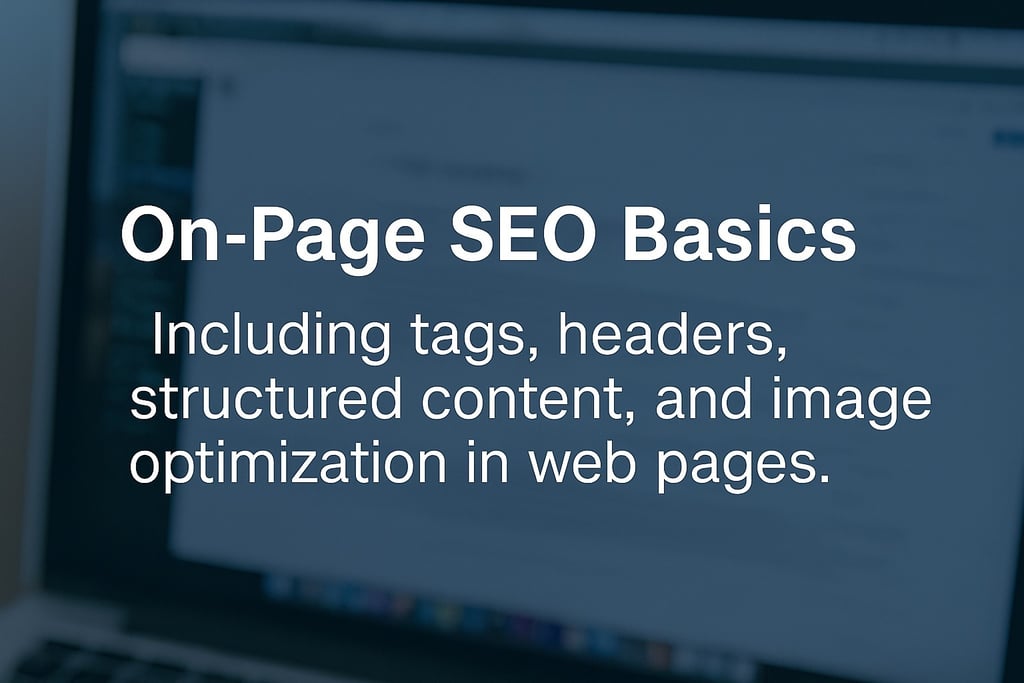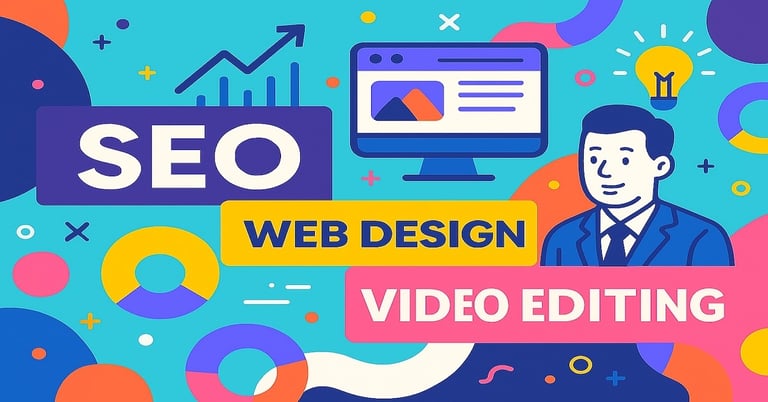GET STARTED - Book a free consultation -or- a $50 Website & SEO Audit report now!
On-Page SEO Basics
A Complete Guide for Small Business Websites
8/4/20253 min read


If you’re wondering how to improve your website’s visibility on Google, mastering On-Page SEO is a critical first step. On-page SEO refers to optimising individual web pages so they rank higher and drive more relevant traffic from search engines. For Australian small business owners, understanding tags, headers, structured content, and image optimisation can make the difference between ranking on page 1 or being buried on page 10.
In this article, we’ll explain On-Page SEO basics that will help boost your website’s Google rankings and provide a better user experience.
⸻
Why On-Page SEO Matters for Australian Businesses
Google evaluates your website content to understand its relevance to user search queries. On-Page SEO ensures that your site is:
• Search engine-friendly
• Easy for users to navigate
• Optimised for keywords and search intent
If you’re a local business in Australia—whether you’re an electrician in Brisbane, a café in Toowoomba, or an SEO consultant in Sydney—strong on-page SEO will help you rank higher for local searches like “SEO Services Toowoomba” or “Plumber Brisbane CBD”.
⸻
Essential On-Page SEO Elements
1. Title Tags – The First Clickable Hook
The title tag is what appears as the clickable headline in Google’s search results.
Best practices:
• Include your primary keyword (e.g., “Affordable SEO Services Toowoomba”)
• Keep titles under 60 characters
• Add your business name if space allows
• Make it engaging to improve click-through rates (CTR)
Example: “On-Page SEO Services Brisbane | Boost Your Google Rankings”
⸻
2. Meta Descriptions – Summarising Your Page’s Value
Meta descriptions appear below the title in search results. While not a direct ranking factor, they influence CTR.
Tips:
• Use relevant keywords naturally
• Write a concise summary (150-160 characters)
• Include a call-to-action like “Get a Free SEO Audit Today”
⸻
3. Header Tags (H1, H2, H3) – Structuring Content for Readability & SEO
Header tags organise your content, making it easier for users and Google to understand the page’s hierarchy.
• H1 Tag: Main title of the page (should only have ONE per page)
• Example: “On-Page SEO Basics for Small Business Websites”
• H2 Tags: Subheadings that outline main sections
• Example: “How to Optimise Title Tags for SEO”
• H3 Tags: Further sub-sections under H2s
• Example: “Tips for Crafting Click-Worthy Titles”
Using keywords in headers helps Google index your content correctly while improving user experience.
⸻
4. Structured Content – Organising Your Page for Google & Users
Structured content is about presenting your information in a clear, logical format. This includes:
• Short paragraphs (2-3 sentences)
• Bullet points & numbered lists
• Highlighting key phrases in bold
• Incorporating internal links to other relevant pages on your website
For example, linking to your “SEO Services” page when discussing optimisation strategies boosts SEO through better site architecture.
⸻
5. Image Optimisation – Don’t Ignore Your Visual Content
Google can’t ‘see’ images, so it relies on image attributes to understand their context.
Steps for optimising images:
• File Names: Use descriptive, keyword-rich file names (e.g., “seo-services-toowoomba.jpg”)
• Alt Text: Write clear alt text that describes the image (e.g., “Screenshot of Google Search Console SEO Report”)
• Image Compression: Use tools like TinyPNG to reduce file size and improve page speed
• Responsive Images: Ensure images scale properly on mobile devices
⸻
Bonus On-Page SEO Tips for Australian Businesses
• URL Structure: Keep URLs clean and include keywords. Example: www.yoursite.com/on-page-seo-guide
• Mobile-Friendly Design: Over 60% of Australian searches are mobile, so ensure your site is responsive.
• Page Load Speed: Use tools like Google PageSpeed Insights to test and optimise your site speed.
• Schema Markup: Implement schema.org markup for reviews, business info, and FAQs to enhance rich snippets in search results.
⸻
Common On-Page SEO Mistakes to Avoid
• Stuffing too many keywords unnaturally
• Using multiple H1 tags on a single page
• Forgetting to add image alt text
• Writing meta descriptions that are too long or irrelevant
• Ignoring internal linking opportunities
⸻
Conclusion
Mastering on-page SEO basics—from title tags and meta descriptions to headers, structured content, and image optimisation—is essential for improving your website’s Google search rankings. For local Australian businesses, these optimisations are key to outranking competitors and attracting local traffic.
By consistently applying these on-page SEO strategies, you’ll not only boost your visibility but also provide a better experience for your website visitors, leading to higher engagement and conversions.
Our Solutions for you
Expert SEO, website design, content creation and digital marketing services.
Serving South East Queensland including Darling Downs, Lockyer Valley, Toowoomba and Brisbane in person.
All work is done in Australia.
Connect
SEODevPro
+61 493258833
info@SEODevPro.com
© 2025. All rights reserved. OneMindSoftware ABN 33 129 219 462
Created using Hostinger Web Builder
Mon-Fri 9:00 - 17:00 AEST
Business Hours


Want a FREE Password Manager that requires:
- No login
- No memory
- No cloud
Check out https://calcpass.app
